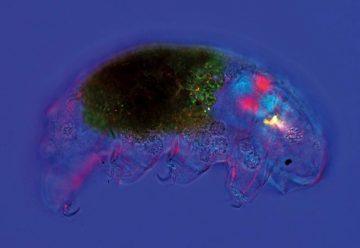Jonathan Shaw in Harvard Magazine:
 SYNTHETIC BIOLOGY, or the application of engineering principles to the design of life, presents world-changing prospects. Could components of a living cell function as tiny switches or circuits? How would that allow biomedical engineers to build biological “smart devices”—from sensors deployed inside the body to portable medical kits able to produce vaccines and antibiotics on demand? Could bacterial “factories” replace the fossil-fueled industries that produce plastics, foods, and fertilizers? Will the secrets of living creatures that enter suspended animation during periods of drought and extreme cold be harnessed to keep human victims of trauma alive? And is the genetic information preserved in long-frozen or fossilized extinct species, like woolly mammoths, sufficiently recoverable to help save living species?
SYNTHETIC BIOLOGY, or the application of engineering principles to the design of life, presents world-changing prospects. Could components of a living cell function as tiny switches or circuits? How would that allow biomedical engineers to build biological “smart devices”—from sensors deployed inside the body to portable medical kits able to produce vaccines and antibiotics on demand? Could bacterial “factories” replace the fossil-fueled industries that produce plastics, foods, and fertilizers? Will the secrets of living creatures that enter suspended animation during periods of drought and extreme cold be harnessed to keep human victims of trauma alive? And is the genetic information preserved in long-frozen or fossilized extinct species, like woolly mammoths, sufficiently recoverable to help save living species?
These ideas, once the stuff of science fiction, are now the stuff of science. Some aren’t yet functioning realities, but others have launched business applications, whether in medicine (such as hospital gowns that signal exposure to infection) or in land remediation (where bacterial “factories” powered by the sun capture nitrogen from the atmosphere to help plants grow). Someday, engineered forms of life that store carbon may even be one of the solutions to Earth’s climate-change problem.
“Most of biology, historically, has been analyzing how nature works,” says Donald Ingber, director of Harvard’s Wyss Institute for Biologically Inspired Engineering. Systems biology is the culmination of that effort to deconstruct natural processes. Now, with synthetic biology, he points out, scientists “are at the point where we know enough that we can actually engineer artificial and natural biological systems.” Researchers today can build things from biological parts, and even create hybrid systems by linking them to non-living machines. Propelling the science forward are scores of innovations in biological science, with new discoveries coming every month. Among the most important are advances in genetic editing, including improvements in accuracy, and the ability to make hundreds of changes at once.
More here.
